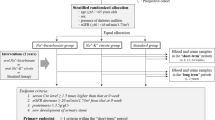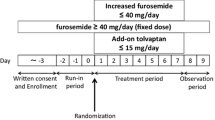Abstract
Background
To investigate the efficacy and safety of oral N-acetylcysteine (NAC) for preserving residual renal function in patients undergoing hemodialysis.
Methods
Randomized, multi-center, parallel-group, open-label clinical trial (Registration No. IRCT 2014071418482N1). 54 patients who have been undergoing hemodialysis for at least 3 months and had residual urine volume >100 ml/24 h were randomly allocated to NAC or no medication. Residual renal function evaluated by (1) estimated glomerular filtration rate (GFR), (2) 24 h urine volume, and (3) renal Kt/V. GFR and Kt/V was determined at baseline and after 3 months. 24 h urine volume was measured at baseline, after 1, 2, and 3 months.
Results
Intention-to-treat analysis was performed on 47 patients (NAC = 26, control = 21). GFR in patients receiving NAC improved, whereas in the control arm a decline of 1.0 ml/min/1.73 m2 was recorded (3.59 vs. 2.11 ml/min/1.73 m2, effect size = 17.0 %, p = 0.004). For 24 h urine volume, the between-group difference after 1 month was significant (669 vs. 533 ml/24 h, effect size = 15.4 %, p = 0.004). After 3 months, 24 h urine volume in the NAC arm was on average 137 ml higher than in the control group, and the difference reached near significance (673 vs. 536 ml/24 h, p = 0.072). In the follow-up visit, Kt/V was higher in the NAC arm but the difference did not reach statistical significance (0.81 vs. 0.54, p = 0.152).
Conclusion
Three months treatment with NAC appears to be effective in preserving renal function in patients undergoing hemodialysis and the medication is generally well-tolerated.


Similar content being viewed by others
References
Bargman JM, Thorpe KE, Churchill DN. Relative contribution of residual renal function and peritoneal clearance to adequacy of dialysis: a reanalysis of the CANUSA study. J Am Soc Nephrol JASN. 2001;12(10):2158–62 (PubMed PMID: 11562415. Epub 2001/09/20.eng).
Termorshuizen F, Dekker FW, van Manen JG, Korevaar JC, Boeschoten EW, Krediet RT, et al. Relative contribution of residual renal function and different measures of adequacy to survival in hemodialysis patients: an analysis of the Netherlands cooperative study on the adequacy of dialysis (NECOSAD)-2. J Am Soc Nephrol. 2004;15(4):1061–70.
Wang AY, Lai KN. The importance of residual renal function in dialysis patients. Kidney Int. 2006;69(10):1726–32 (PubMed PMID: 16612329. Epub 2006/04/14.eng).
Raimann JG, Kitzler TM, Levin NW. Factors affecting loss of residual renal function(s) in dialysis. Contrib Nephrol. 2012;178:150–6 (PubMed PMID: 22652730. Epub 2012/06/02.eng).
Termorshuizen F, Korevaar JC, Dekker FW, van Manen JG, Boeschoten EW, Krediet RT. The relative importance of residual renal function compared with peritoneal clearance for patient survival and quality of life: an analysis of the Netherlands cooperative study on the adequacy of dialysis (Necosad)-2. Am J Kidney Dis. 2003;41(6):1293–302.
Shemin D, Bostom AG, Laliberty P, Dworkin LD. Residual renal function and mortality risk in hemodialysis patients. Am J Kidney Dis. 2001;38(1):85–90.
Liao CT, Chen YM, Shiao CC, Hu FC, Huang JW, Kao TW, et al. Rate of decline of residual renal function is associated with all-cause mortality and technique failure in patients on long-term peritoneal dialysis. Nephrol Dial Transplant Off Publ Eur Dial Transpl Assoc Eur Renal Assoc. 2009;24(9):2909–14 (PubMed PMID: 19225016. Epub 2009/02/20.eng).
Thomas J, Teitelbaum I. Preservation of residual renal function in dialysis patients. Adv Perit Dial Conf Perit Dial. 2011;27:112–7 (PubMed PMID: 22073841. Epub 2011/11/12.eng).
Vilar E, Farrington K. Emerging importance of residual renal function in end-stage renal failure. Semin Dial. 2011;24(5):487–94 (PubMed PMID: 21999737. Epub 2011/10/18.eng).
Feldman L, Shani M, Sinuani I, Beberashvili I, Weissgarten J. N-acetylcysteine may improve residual renal function in hemodialysis patients: a pilot study. Hemodial Int. 2012;16(4):512–6.
Feldman L, Abu Hamad R, Efrati S, Ashker A, Beberashvili I, Shani M. Effect of N-acetylcysteine on residual renal function in chronic haemodialysis patients treated with high-flux synthetic dialysis membranes: a pilot study. ISRN Nephrol. 2012;2013:636208.
Feldman L, Shani M, Efrati S, Beberashvili I, Yakov-Hai I, Abramov E, et al. N-Acetylcysteine improves residual renal function in peritoneal dialysis patients: a pilot study. Perit Dial Int. 2011;31(5):545–50.
Rushworth GF, Megson IL. Existing and potential therapeutic uses for N-acetylcysteine: the need for conversion to intracellular glutathione for antioxidant benefits. Pharmacol Ther. 2014;141(2):150–9.
Rodrigues SD, Franca KC, Dallin FT, Fujihara CK, Nascimento AJ, Pecoits-Filho R, et al. N-Acetylcysteine as a potential strategy to attenuate the oxidative stress induced by uremic serum in the vascular system. Life Sci. 2015;121:110–6 (PubMed PMID: 25500303. Epub 2014/12/17.eng).
Girouard H, Chulak C, Wu L, Lejossec M, de Champlain J. N-acetylcysteine improves nitric oxide and alpha-adrenergic pathways in mesenteric beds of spontaneously hypertensive rats. Am J Hypertens. 2003;16(7):577–84 (PubMed PMID: 12850392. Epub 2003/07/10.eng).
Efrati S, Berman S, Ilgiyeav I, Siman-Tov Y, Averbukh Z, Weissgarten J. Differential effects of N-acetylcysteine, theophylline or bicarbonate on contrast-induced rat renal vasoconstriction. Am J Nephrol. 2009;29(3):181–91 (PubMed PMID: 18781062. Epub 2008/09/11.eng).
Daugirdas JT. Second generation logarithmic estimates of single-pool variable volume Kt/V: an analysis of error. J Am Soc Nephrol JASN. 1993;4(5):1205–13 (PubMed PMID: 8305648. Epub 1993/11/01.eng).
The Toxicology Investigator Network Authorship G. A multi-center comparison of the safety of oral versus intravenous acetylcysteine for treatment of acetaminophen overdose. Clin Toxicol (Phila Pa). 2010;48(5):424–30. (PubMed PMID: PMC2894984).
Sandilands EA, Bateman DN. Adverse reactions associated with acetylcysteine. Clin Toxicol. 2009;47(2):81–8.
Atkuri KR, Mantovani JJ, Herzenberg LA, Herzenberg LA. N-Acetylcysteine—a safe antidote for cysteine/glutathione deficiency. Curr Opin Pharmacol. 2007;7(4):355–9.
Grandjean EM, Berthet P, Ruffmann R, Leuenberger P. Efficacy of oral long-term N-acetylcysteine in chronic bronchopulmonary disease: a meta-analysis of published double-blind, placebo-controlled clinical trials. Clin Ther. 2000;22(2):209–21.
Locatelli F, Canaud B, Eckardt KU, Stenvinkel P, Wanner C, Zoccali C. Oxidative stress in end-stage renal disease: an emerging threat to patient outcome. Nephrol Dial Transplant. 2003;18(7):1272–80.
Coombes JS, Fassett RG. Antioxidant therapy in hemodialysis patients: a systematic review. Kidney Int. 2012;81(3):233–46 (PubMed PMID: 21975860. Epub 2011/10/07.eng).
Roberts CK, Sindhu KK. Oxidative stress and metabolic syndrome. Life Sci. 2009;84(21–22):705–12.
Ceballos-Picot I, Witko-Sarsat V, Merad-Boudia M, Nguyen AT, Thévenin M, Jaudon MC, et al. Glutathione antioxidant system as a marker of oxidative stress in chronic renal failure. Free Radic Biol Med. 1996;21(6):845–53.
Trimarchi H, Mongitore M, Baglioni P, Forrester M, Freixas E, Schropp M, et al. N-Acetylcysteine reduces malondialdehyde levels in chronic hemodialysis patients—a pilot study. Clin Nephrol. 2003;59(6):441–6.
Thaha M, Pranawa W, Yogiantoro M, Tomino Y. Intravenous N-acetylcysteine during hemodialysis reduces asymmetric dimethylarginine level in end-stage renal disease patients. Clin Nephrol. 2008;69(1):24–32 (PubMed PMID: 18226399. Epub 2008/01/30.eng).
Swarnalatha G, Ram R, Neela P, Naidu M. Oxidative stress in hemodialysis patients receiving intravenous iron therapy and the role of N-acetylcysteine in preventing oxidative stress. Saudi J Kidney Dis Transplant. 2010;21(5):852.
Tepel M, van der Giet M, Statz M, Jankowski J, Zidek W. The antioxidant acetylcysteine reduces cardiovascular events in patients with end-stage renal failure a randomized, controlled trial. Circulation. 2003;107(7):992–5.
Ivanovski O, Szumilak D, Nguyen-Khoa T, Ruellan N, Phan O, Lacour B, et al. The antioxidant N-acetylcysteine prevents accelerated atherosclerosis in uremic apolipoprotein E knockout mice. Kidney Int. 2005;67(6):2288–94.
McPherson RA, Hardy G. Cysteine: the Fun-Ke nutraceutical. Nutrition. 2012;28(3):336–7.
Martina V, Masha A, Gigliardi VR, Brocato L, Manzato E, Berchio A, et al. Long-term N-acetylcysteine and l-arginine administration reduces endothelial activation and systolic blood pressure in hypertensive patients with type 2 diabetes. Diabetes Care. 2008;31(5):940–4.
Acknowledgments
This study was part of a MD thesis supported by Tehran University of Medical Sciences. The present study was supported by Tehran University of Medical Sciences (Grant No.) (Registration No. IRCT 2014071418482N1).
Author information
Authors and Affiliations
Corresponding author
Ethics declarations
Conflict of interest
None declared.
About this article
Cite this article
Ahmadi, F., Abbaszadeh, M., Razeghi, E. et al. Effectiveness of N-acetylcysteine for preserving residual renal function in patients undergoing maintenance hemodialysis: multicenter randomized clinical trial. Clin Exp Nephrol 21, 342–349 (2017). https://doi.org/10.1007/s10157-016-1277-5
Received:
Accepted:
Published:
Issue Date:
DOI: https://doi.org/10.1007/s10157-016-1277-5




